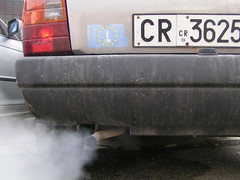 Image by Simone Ramella via FlickrBy Harold Forbes
Image by Simone Ramella via FlickrBy Harold ForbesRoad transportation is the second biggest source of energy-based carbon emission in the world and one of the easiest to make major cuts in.
Pedal bikes are cheap, efficient and virtually emissions free but they do have limited range and load carrying abilities for most people. It is reasonable to assume that the popularity of cars will continue and, while there are electric or hydrogen-powered alternative the proportion of the population that buys new cars is fairly small compared to the existing stock on the roads and only about one in 20 cars on the road are in their first year of registration.
Whether it is new or old, if you are a car owner, the key to your carbon intensity is the number of miles you travel in it. The more miles you travel, the more the total carbon dioxide emitted. Although this might seem self-evident, many people believe get don't make the connection. For example, many people think that the 'school run' must be a major source of emissions because of the noticeable decease in traffic in urban areas when the school holidays start and subsequent increase when they return. In fact, in the UK, the school run only accounts for 4% of passenger car emissions.
There are two strategies to make a quick impact on your car emissions. The first is taking a passenger. The single biggest source of transport CO2 is from those journeys of 5 to 25 miles producing 43% of car emissions, while the 7% of journeys that are over 25 miles produce a whopping 38% of car emissions.
The shorter journeys are probably mostly commuting, the single biggest source of traffic by type of journey taken. Commuting involves a high proportion of single occupancy vehicles. By definition, commuting is going from home to your place of work, so by deduction, your place of work may contain co-workers who make a similar journey to you. This is the type of behaviour change that people generally find difficult to engage with. They fiercely defend their usually imaginary, ability to leave the house and office at exactly the time of their choosing, to select the perfect temperature in the cabin of the car and to relax to their favourite radio station or CD. The reality of the trip is seldom like that, of course, so why not expand your humanity and bring a buddy? The conversation can distract from the jams.
Obviously, the arguments for lift sharing are even stronger on longer journeys and there are a number of website dedicated to matching travellers. Give them a try and you will probably end up meeting a wide variety of people: what better networking opportunity could there be? And remember, sharing you car has a multiplicative effect in cutting carbon.
The second strategy is to watch your speed.
In the UK, the majority of cars on motorways are travelling at 70mph or more regardless of the speed limit. Not so long ago, my own driving habits were consistent with the majority, but then I tried an experiment that has changed my habits completely. I had a business meeting to attend and decided I would drive there in my normal way (trying to keep up with the traffic flow or at least the guy two cars in front of me) and I would drive back limiting my speed to either the speed limit or 60mph where the 70mph speed limit applied. I used the car's trip computer to measure the results and they staggered me.
The journey was 159 miles and the outbound leg had an average speed of 51.7mph and fuel consumption of 38.1 mpg. The return leg gave an average speed of 48.6 mph and 48.6 mpg (yes, they are exactly the same number but I did double check the numbers). That is an incredible 27% increase in fuel efficiency for just a 6.5% increase in time travelled. This is a sizable figure and as more than a quarter of car miles are driven on motorways or trunk roads then easing up on the speed would, by my calculation, reduce car emissions by about 6%. Adding in the saving from doubling up on the commute would bring the total emission saving up to about 20%.
Taking action to cut our carbon emissions to reclaim a safe climate is now an urgent task. On present trends, we are on course for a warming of 4 degree Celsius by mid-century: only half a lifetime away. At that level, natural systems will begin to breakdown, making growing enough food for the human population next to impossible. That, combined with the increased frequency and violence of extreme weather events costing billions of dollars, will very likely cause civilisation as we know it to fall. Carrying on as "normal" will ensure that life become anything but: we need action now to reclaim a safe climate.
The biggest challenge is to make carbon reducing mainstream activity. Taking passengers and cutting your speed is a simple way to contribute to that.
Harold Forbes is Author of "How to be a Humankind Superhero: a manifesto for individuals to reclaim a safe climate". The book uses the myth of Hercules to provide individuals with twelve impactful action areas to fight climate change. It has been described by Jonathan Porritt, an eminent figure in the area of sustainable development as "An enjoyable read that hits the elusive balance between the analytic and the practical" and by the author Iain Banks as "a fine and heartfelt piece of work". Climate change has been described as the greatest threat facing humankind. "How to be a Humankind Superhero" empowers and inspires meaningful individual action. You can read chapter summaries at http://www.hksuperh.com or download the first chapter as a FREE PDF at http://bit.ly/freehksh.
Article Source: http://EzineArticles.com/?expert=Harold_Forbes
http://EzineArticles.com/?Practical-Actions-To-Reclaim-A-Safe-Climate:-Car-Transportation&id=6293001

No comments:
Post a Comment